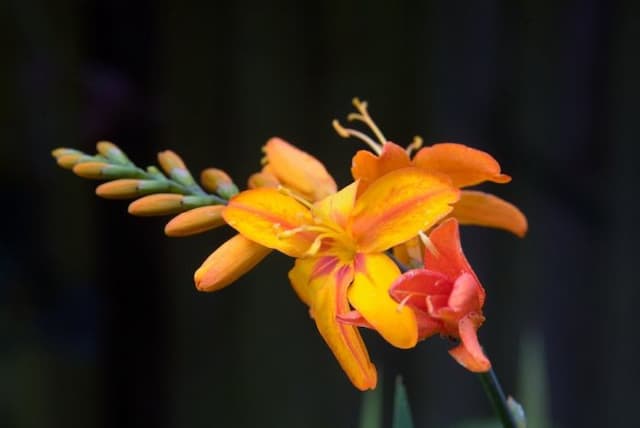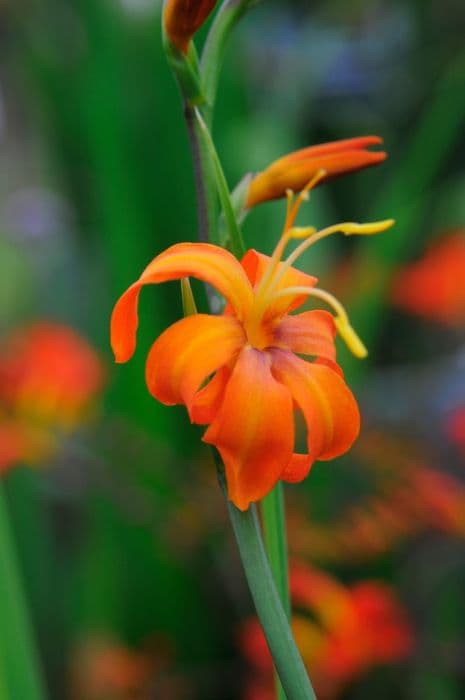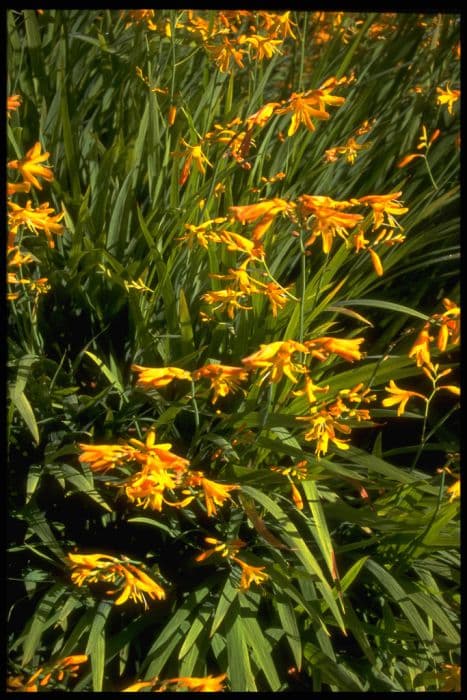Siberian Iris Iris 'Isla Serle' (Sib)

ABOUT
Iris 'Isla Serle' is known for its captivating beauty, which is characterized by its distinctive flowers and foliage. The plant features showy blooms that are often admired for their unique shape and vibrant coloration. The flowers display a harmonious blend of colors, typically ranging from rich blues and purples to lighter shades that can include yellows or whites, often with intricate veining or speckling that adds to their ornate appearance. Each flower is composed of several parts: the "falls" which are the three lower petals that may hang down or flair out; the "standards" which are the three upper petals that stand upright; and the "beard," which is a fuzzy or brush-like feature in the center of the falls. The beard is not just decorative but also serves to attract pollinators to the bloom. The foliage of Iris 'Isla Serle' adds to its aesthetic appeal, with long, sword-shaped leaves that grow in a dense clump. The leaves are a deep green color, providing a lush, contrasting backdrop for the strikingly colored flowers that rise above on sturdy, vertical stems. The foliage forms a fan-like pattern as it arches outwards from the base of the plant, giving it a graceful and structured appearance. Overall, Iris 'Isla Serle' is a plant known for its stunning blooms and foliage which contribute to its popularity among garden enthusiasts. It provides a dramatic display when in flower and adds elegance to any garden with its foliage even when it's not in bloom.
About this plant
 Names
NamesFamily
Iridaceae.
Synonyms
Iris 'Isla Serle', Siberian Iris.
Common names
Iris 'Isla Serle' (Sib).
 Toxicity
ToxicityTo humans
Siberian iris, the common name for Iris 'Isla Serle', generally poses minimal toxicity to humans. However, if ingested, this plant can cause mild stomach upset due to its mild irritant properties. Contact with the sap may also result in skin irritation or allergic reactions in some individuals. The rhizomes (roots) are more likely to contain irritants.
To pets
Siberian iris may also have mild toxicity to pets. If ingested, particularly the rhizomes, it could potentially cause gastrointestinal symptoms such as drooling, vomiting, or diarrhea. In most cases, toxicity is not severe, but it is advisable to discourage pets from eating the plant, and to consult a veterinarian if significant amounts are consumed.
 Characteristics
CharacteristicsLife cycle
Perennials
Foliage type
Deciduous
Color of leaves
Green
Flower color
Varies
Height
2-3 feet (60-90 cm)
Spread
1-2 feet (30-60 cm)
Plant type
Bulb
Hardiness zones
3-9
Native area
Siberia
Benefits
 General Benefits
General Benefits- Decorative Appeal: Iris 'Isla Serle', commonly known as the Siberian Iris, has strikingly beautiful flowers that enhance the aesthetic of gardens and landscapes.
- Drought Tolerance: Siberian Irises are relatively drought-tolerant once established, making them suitable for gardens with less frequent watering needs.
- Cold Hardiness: This cultivar is known for its ability to withstand cold temperatures, making it a resilient choice for gardens in cooler climates.
- Low Maintenance: Siberian Irises do not require a lot of care once they are established, which makes them ideal for gardeners seeking low-maintenance plants.
- Attracts Pollinators: The flowers of the Siberian Iris attract bees, butterflies, and other beneficial insects, supporting local ecosystems.
- Soil Versatility: They are adaptable to a variety of soil conditions, although they prefer well-drained soils.
- Erosion Control: Their robust root systems can help stabilize soil and prevent erosion, making them a practical choice for sloped areas.
- Seasonal Interest: Siberian Irises provide seasonal interest with their attractive foliage and bloom in late spring to early summer.
- Companion Planting: They pair well with other perennials in a garden setting, offering complimentary textures and colors.
- Naturalizing: Siberian Irises can spread and form naturalized areas over time, creating a beautiful, wild look in the landscape.
 Medical Properties
Medical PropertiesThis plant is not used for medical purposes.
 Air-purifying Qualities
Air-purifying QualitiesThis plant is not specifically known for air purifying qualities.
 Other Uses
Other Uses- Fabric dye: The rhizomes of the Siberian iris can be used to produce natural dyes for fabrics, imparting hues ranging from yellow to green depending on the mordant used.
- Artistic inspiration: The striking colors and unique form of the Siberian iris can inspire artists and be featured in paintings, drawings, or as part of botanical illustration studies.
- Floral arrangements: Siberian iris flowers can add height, texture, and vivid color to both fresh and dried floral arrangements.
- Photography: They are a popular subject for photographers, particularly in garden and nature photography, because of their aesthetic appeal.
- Garden design: Siberian irises can be used in water feature gardens, as they are tolerant of moist soil conditions and can enhance the beauty of ponds or streamsides.
- Eco-friendly confetti: Dried petals of the Siberian iris can be used as biodegradable confetti for outdoor celebrations, reducing environmental impact.
- Education: These plants can be used in educational settings to teach about plant biology, hybridization, and horticultural practices.
- Culinary garnish: Although not widely known for culinary uses, the petals of Siberian iris are edible and can be used as a delicate garnish for desserts and salads.
- Crafts: The leaves and stems can be woven into baskets or used as natural ties in garden trellising or floral crafts.
- Perfumery: Some iris species are used in perfumery for their rhizomes (orris root), which after aging develop a pleasant scent used in perfumes and potpourris; this practice could be explored with Siberian iris as well.
Interesting Facts
 Feng Shui
Feng ShuiThe Iris is not used in Feng Shui practice.
 Zodiac Sign Compitability
Zodiac Sign CompitabilityThe Iris is not used in astrology practice.
 Plant Symbolism
Plant Symbolism- Hope: The Iris represents hope, reflecting its role in mythology where it was a link between heaven and earth.
- Wisdom: It is symbolic of wisdom, often depicted in art and literature as a guiding symbol of insight.
- Courage: In some cultures, the Iris is a symbol of courage, inspired by its bold colors and elegant shape.
- Faith: The Iris can signify faith, relating to the trust and belief that spring will return and the flower will bloom again.
- Purity: White Irises, in particular, convey purity and innocence, making them a common choice in bridal bouquets and religious ceremonies.
- Royalty: With its regal appearance, the Iris can represent royalty and majesty, reminiscent of its use in the French monarchy's Fleur-de-lis emblem.
 Water
WaterSiberian Irises, such as the 'Isla Serle', require consistent moisture, particularly during their growth and bloom periods. Watering should be done early in the morning to allow the foliage to dry before nightfall. Ensure that the soil is kept evenly moist but not waterlogged. During active growth in spring and early summer, aim for about 1 inch of water per week, which equates to approximately 0.6 gallons per square yard. In the absence of rain, provide supplemental watering to maintain the moisture level. Reduce watering after blooming and in the fall to help prepare the plants for winter.
 Light
LightSiberian Irises, like 'Isla Serle', thrive best in full sun to partial shade. They require at least 6 hours of direct sunlight daily to perform optimally. An ideal spot would be one where the morning sun can reach them while offering some shade during intense afternoon heat, particularly in hotter climate zones. A location that simulates their native stream and woodland edges, with bright but dappled or filtered afternoon light, is perfect.
 Temperature
TemperatureSiberian Iris 'Isla Serle' is tolerant of a wide range of temperatures but grows best when the temperature is between 68°F and 86°F. They can survive winter temperatures down to about -40°F, indicating their hardiness. Summer extremes above 95°F may slow their growth and lead to stress, so providing some afternoon shade in hotter regions can be beneficial. The plant's resilience makes it suitable for many climates where the temperatures remain within their survivable range.
 Pruning
PruningPruning Siberian Iris 'Isla Serle' is mainly focused on aesthetic and health reasons. Remove spent flowers after blooming to ensure the plant doesn't expend energy on seed production. In late fall or early winter, cut back the foliage to a few inches above the ground to tidy up the plant and prevent pest and disease issues. Pruning can be done once a year, typically following the end of the bloom period or when the foliage begins to die back naturally.
 Cleaning
CleaningAs needed
 Soil
SoilSiberian Iris 'Isla Serle' thrives in a well-draining, rich soil mixture with a slightly acidic to neutral pH, ranging from 6.5 to 7.0. A mixture of loam, compost, and sand is ideal, ensuring adequate drainage and fertility for optimal growth.
 Repotting
RepottingSiberian Iris 'Isla Serle' typically does not require frequent repotting and can be done every few years. It is best to repot or divide these irises after flowering, usually in late summer, to allow them to become established before the first frost.
 Humidity & Misting
Humidity & MistingSiberian Iris 'Isla Serle' is tolerant of a range of humidity levels and does not have specific humidity requirements, thriving in average outdoor humidity conditions.
 Suitable locations
Suitable locationsIndoor
Place Siberian Iris 'Isla Serle' in bright, indirect light and keep soil moist.
Outdoor
Plant in full sun to partial shade, moist soil, and provide winter mulch.
Hardiness zone
3-9 USDA
 Life cycle
Life cycleThe Iris 'Isla Serle', commonly known as a variety of Siberian Iris, begins its life cycle when a seed is sown in moist, well-drained soil after the last frost of spring. It germinates and develops into a seedling, showing its first shoots and leaves as it emerges from the soil. As the plant matures, it forms a clump of grass-like leaves and establishes a robust root system. In the following spring or early summer, it produces tall flowering stalks bearing the characteristic Iris blooms, which can be various shades of purple, blue, pink, or white. After the blooming period, the flowers fade, and the plant sets seed in a capsule-like fruit if pollination has occurred. Outside of the flowering period, the Siberian Iris continues to grow vegetatively, storing energy in its rhizomes for the next season's growth and bloom cycle, with the plant requiring division every 3-4 years to maintain vigor.
 Propogation
PropogationPropogation time
Spring to Summer
The most popular method of propagating Iris 'Isla Serle', commonly known as Siberian Iris, is through division. This is best done in the late summer after flowering has finished or in the early fall. To propagate Siberian Iris by division, gently lift the clump from the soil using a spade or fork, being careful not to damage the rhizomes more than necessary. The clumps should then be separated into smaller sections, each with several healthy fans of leaves and a portion of the rhizome. Trim the leaves to about a third of their height to reduce water loss and replant the divisions at the same depth they were growing previously, spacing them about 18 to 24 inches (approximately 45 to 60 centimeters) apart to allow for growth. Water the new divisions well to help establish them. This method not only propagates new plants but also rejuvenates older clumps, encouraging more vigorous growth and flowering in subsequent seasons.
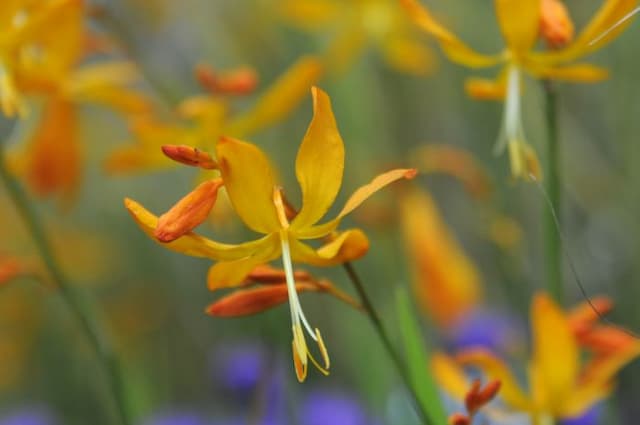
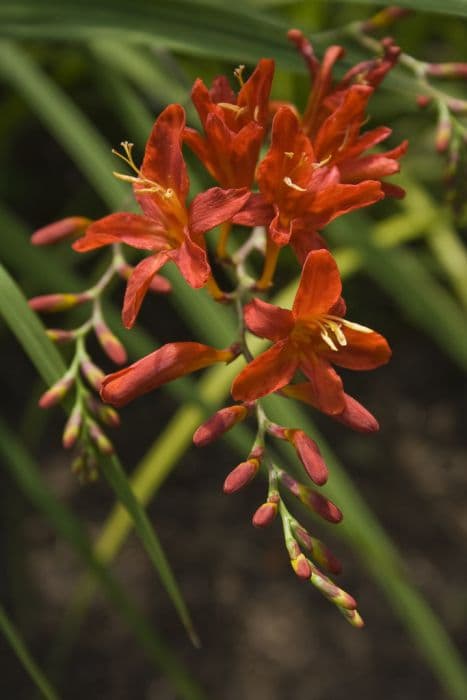
![Montbretia [Bright Eyes]](/_next/image?url=https%3A%2F%2Fplants-admin.emdemapps.com%2Fimages%2Fplants%2F%2Fimages%2F604b5f4a483b6.png&w=640&q=75)
